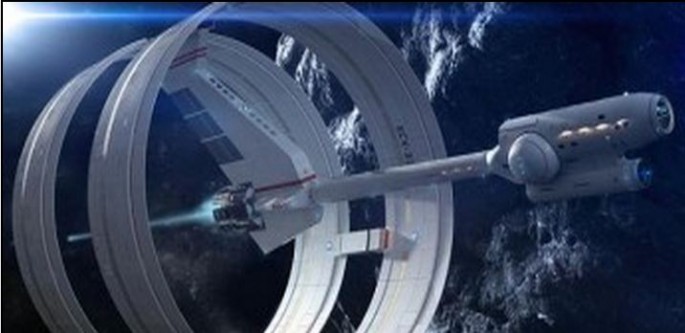The dream of traveling faster than the speed of light remains just that -- a dream -- since it's considered impossible by the Theory of Relativity. A recent test by NASA on a controversial technology that seems to violate the laws of physics, however, might have actually accelerated particles faster than light speed.
If confirmed, this test will prove traveling faster than the speed of light is truly possible. The implications of this breakthrough for human spaceflight will be game changing.
The Electromagnetic Drive or EM Drive (also called a RF resonant cavity thruster) is a proposed spacecraft propulsion device invented by British aerospace engineer Roger Shawyer, who develops prototypes of this drive at Satellite Propulsion Research Ltd, a company he founded for this purpose.
The EM Drive uses a magnetron to produce microwaves directed into a metallic, fully enclosed conically tapered high Q resonant chamber with a greater area at the large end of the device, and a dielectric resonator in front of the narrower end.
Shawyer claims the device generates a directional thrust toward the narrow end of the tapered cavity. The engine requires an electrical power source to produce its reflecting internal microwaves but does not have any moving parts or require any reaction mass as fuel.
If it works as claimed, the EM Drive could be used to propel vehicles intended for all forms of travel including spaceflight, air travel, ground travel, marine travel and submarine travel.
NASA believes a future EM Drive could make a trip to the Moon possible in just four hours instead of three days. A trek to Mars could take just 70 days instead of the 270 days using chemical propulsion rockets.
More specifically, an EM engine will allow NASA to send manned missions to the Red Planet in 70 days and return these missions to Earth also in 70 days. The missions would stay on Mars for 90 days.
An EM Drive will allow a manned mission to reach the Saturnian moons of Titan and Enceladus in only nine months with another nine months for the return trip to Earth. NASA said this would result in a total mission duration of just 32 months, including a six-month in-situ mission each at Titan and Enceladus.
A trip to the Alpha Centauri system, the nearest star system to our solar system and 4.3 light years away, will take 92 years using the EM Drive traveling at 9.4 percent of the speed of light compared to the 165,000 years using current technology.
In a recent experiment, a team of NASA researchers fired lasers into a resonance chamber and discovered the particles were accelerated to incredible speeds -- some particles moved faster than the speed of light, said NASA.
NASA reported "...this signature (the interference pattern) on the EM Drive looks just like what a warp bubble looks like. And the math behind the warp bubble apparently matches the interference pattern found in the EM Drive."
Experts said it's possible NASA created a "warp bubble", or deformation in spacetime that can hurl the spacecraft through spacetime at 10 times the speed of light.
The EM Drive, however, remains controversial since the proposed theories of its operation have all been criticized because they seem to violate the conservation of momentum, a fundamental law of physics. Skeptics argue the experimental results from tests of the EM Drive are simply misinterpretations of spurious effects mixed with experimental errors.
Any apparently reactionless drive is treated with skepticism by the physics community because a truly reactionless drive would violate the law of conservation of momentum. This lack of propellant expulsion would leave nothing to balance the change in the spacecraft's momentum if it were able to accelerate.
NASA said the ultimate goal of its experiments is to find out whether it's possible for a spacecraft traveling at conventional speeds to achieve effective superluminal speed by contracting space in front of it and expanding space behind it, or by creating a warp bubble. The experimental results so far had been inconclusive.



























